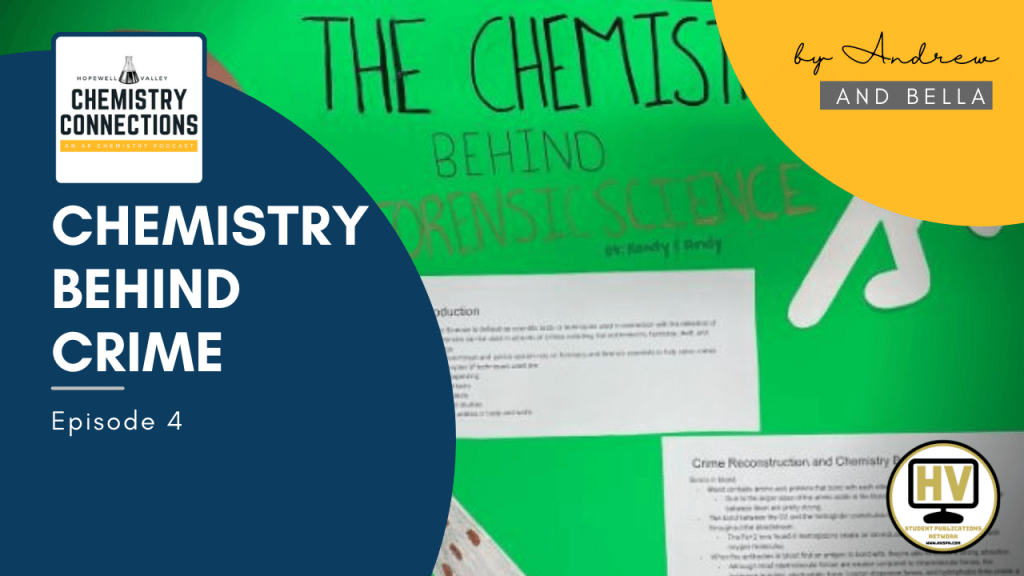Chemistry Behind Crime

Hopewell Valley Student Podcasting Network
Chemistry Connections
Episode #4
Welcome to Chemistry Connections, my name is Andrew Neal and Isabella Randazzo and I am your host for episode 4 called The Chemistry Behind Crime today we will be discussing forensics science and the chemistry behind it.
Segment 1: Introduction to Forensic Science
-Forensic Science is defined as scientific tests or techniques used in connection with the detection of crime, forensics can be used in all sorts of crimes including, but not limited to, homicide, theft, and kidnappings.
-the US government and justice system rely on forensics and forensic scientists to help solve crimes
-some examples of techniques used are
– fingerprinting
-blood tests
-DNA tests
-wound studies
-bullet entries in body and walls
-ect
Segment 2: The Chemistry Behind Blood Testing
So what exactly does AP chem have to do with the study of forensics and crime-solving?
- Blood testing
There are many different challenges that a scientist or investigator might face at a crime scene that might make it difficult to identify blood and find where it came from
- The blood could belong to an animal or a human
- The blood could belong to the unsub and not the victim
- All of this said, if blood is found at a crime scene it becomes a crucial part of the investigation, and it’s often only found in small amounts so it is important that testing is done properly and effectively.
What is blood?
- Water, plasma and proteins
-serums and anti serums/ chemical reactions between them
-Serum: The fluid component of blood that separates from the blood cells when a clot is formed
-Antiserum: A combination of antibodies and serum
-Kastle Myers Blood Test and chemical reactions
– A Kastle Myers blood test is used to determine whether a sample is blood or not. The test uses hydrogen peroxide and phenolphthalin, which is reduced phenolphthalein, and the sample. During the test, the sample, a small amount of distilled water, hydrogen peroxide, and phenolphthalin are mixed inside a test tube. If the sample is blood, then the solution will turn a bright pink color. However, if the sample is not blood, then the solution will remain clear.
-The Kastle Myers Blood test is related to chemistry because of the chemical reactions and redox reactions that confirm the sample is blood. If the sample is blood, then a component of blood called hemoglobin, which is the protein in the blood responsible for transporting blood, reacts with hydrogen peroxide. This leads to the formation of an iron-oxo species and hydroxyl radical. Both of these products can cause a redox reaction with the phenolphthalin where either the iron-oxo species and hydroxyl radical are reduced and the phenolphthalin is oxidized into phenolphthalein. Since phenolphthalein creates a bright pink color, it turns the entire solution into a bright pink.
Bonds in blood:
- Blood contains amino acid proteins that bond with each other
- Due to the larger sizes of the amino acids in blood, the londer dispersion forces created between them are pretty strong.
- The bond between the O2 and the hemoglobin contributes to the process of carrying oxygen throughout the bloodstream.
- The Fe+2 ions found in hemoglobins creates an ion induced dipole intermolecular for with oxygen molecules.
- When the antibodies in blood find a specific antigen to bond with, they are able to create a strong attraction.
- Although most intermolecular forces are weaker compared to intramolecular forces, the hydrogen bonding, electrostatic force, London dispersion forces, and hydrophobic links create a very strong attraction force.
– Due to the bond the multitude of intermolecular forces in blood as well as the thickness in blood, blood creates a unique splatter that can be analysed at a crime scene.
– The angle of the blood falling, the heigh of which the blood came from, and the velocity of the blood coming out of the body can all be found from the specific splatter of the blood drops which can be used to reconstruct the crime scene.
Segment 3: Personal Connections
In many shows in recent years, most of the plot in these shows corresponds to crime and solving the cuplrit of the crime. They use forensics science to help them solve these crimes during this process. However, most of the viewers don’t know enough about forensics science to understand how the information at the crime scene led to solving the crime. Therefore, it is important to let people know how forensics science is helpful at a crime scene.
Thank you for listening to this episode of Chemistry Connections. For more student-ran podcasts and digital content, make sure that you visit www.hvspn.com.
Sources:
–https://www.chemeurope.com/en/encyclopedia/Kastle-Meyer_test.html
–https://www.justice.gov/olp/forensic-science
–https://www.ncbi.nlm.nih.gov/pmc/articles/PMC3415751/
Music Credits
Warm Nights by @LakeyInspired

